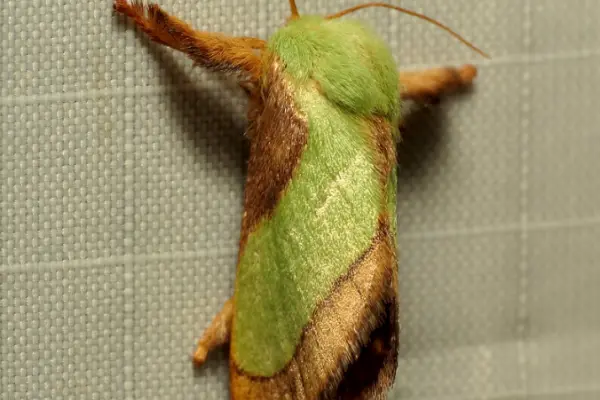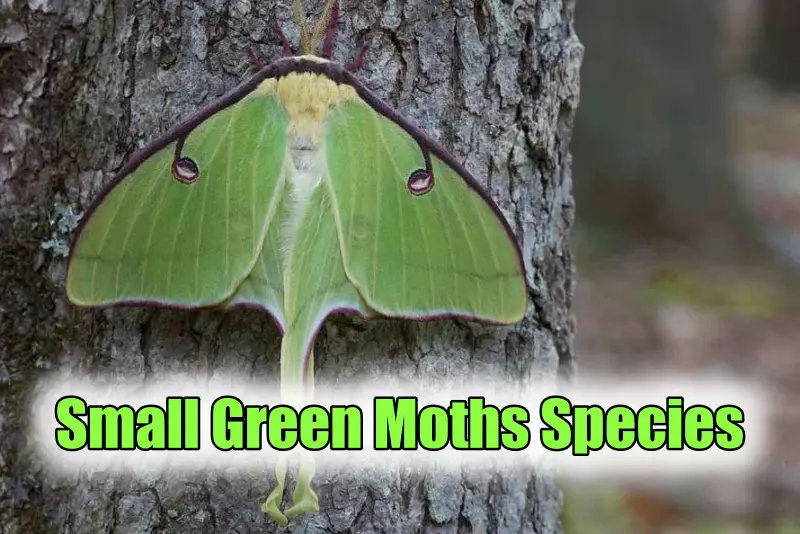It’s not often that we talk about the beauty of moths, especially the small green moths found in our surroundings. While butterflies can often steal the spotlight, moths are equally deserving of appreciation. Moths, typically hardy and often with a hairy exterior (with some exceptions), bring their version of unique charm to nature.
Today, we have for you a comprehensive list of 10 small green moth species from around the world. Despite their small size, don’t let that distract you, as their camouflage game is top-tier.
So, without further ado, I think we should jump straight into it.
10 Small Green Moth Species In The World
1) Green Oak-Slug Moth

Scientific Name: Euclea delphini
Size: 1 cm
The adult spiny oak slug moth is a small moth with a wingspan of around 1 centimeter.
Despite its small size, it has distinctive features that make it stand out, such as its ‘hairy’ brown body and wings.
The upper wings of the spiny oak slug moth showcase a brown color with noticeable green patches, while the underwings have a paler grey-brown hue.
Like many moths, the spiny oak slug moth is primarily nocturnal.
2) Smaller Parasa Moth

Scientific Name: Parasa chloris
Size: 1.8-2.7 cm
The thorax of the smaller parasa is green. The forewing is primarily brown with a large green patch characterized by a nearly straight outer edge.
The hindwing is yellowish with a broad brownish border.
The smaller parasa is found in deciduous forests and ranges from southern New England to Texas.
In the adult stage, the head, thorax, and a thick band on the forewings of the smaller parasa are green.
3) Olive Arta Moth
Scientific Name: Arta olivalis
Size: Approximately 14 mm
The olive arta moth belongs to the snout moth family and is known for its small size.
It also has an olive or greenish hue in its forewings and hindwings.
The olive arta moth was first described by Augustus Radcliffe Grote in 1878.
It is known to inhabit the southern United States.
4) Blotched Emerald
Scientific Name: Comibaena bajularia
Size: 30 to 35 mm
The wings of the adult-blotched emerald moth have a distinctive green coloration with brown and white edges.
The blotched emerald is known to fly in June and July in the southern part of the British Isles.
It is attracted to light, with the male being more drawn to it than the female.
The species is commonly found in oak forests distributed across England and Wales.
5) Small-Grass Emerald
Scientific Name: Chlorissa viridata
Size: 22-26 mm
The Small grass emerald displays dull green wings with a gold edge and distinct white cross-lines.
The small grass emerald is usually found in damp heaths and mosses in southern England and is commonly found flying in June and July.
The adult moths fly at night from dusk and are attracted to light.
6) July highflyer
Scientific Name: Hydriomena furcate
Size: 23–30 mm
The July highflyer moth exhibits a significant variation in both markings and color.
It displays dark cross bands across the wings that vary in intensity and pattern, usually appearing reddish brown to blackish with whitish spots and dark speckles.
The hindwings are generally pale brown, and the edge of the forewing is angled at the near base.
The female July highflyer typically lays their eggs in small groups on the underside of blueberry leaves.
7) Green Carpet
Scientific Name: Colostygia pectinataria
Size: 22 to 28 millimetres
The green carpet moth’s wing pattern displays a plethora of colors, including brownish-green at the wing base and brighter green in the basal region.
In some cases, the greenish color may fade on some older green carpet.
Newly emerged moths can sometimes have a whitish, yellowish, or pink color.
The green carpet moth is a Palearctic species found in various habitats, including moors, marshy terrain, and forests.
The green carpet moth is primarily nocturnal, flying at night in June and July.
8) Oleander Hawk-Moth
Scientific Name: Daphnis nerii
Size: Approximately 9 to 12 centimeters
The adult oleander hawkmoth has a distinctive appearance, with the head being greenish with rufous in front and a grey band on the vertex.
The thorax of the oleandar hawk moth is green, with a triangular grey patch on the vertex.
Forewings are dark green with whitish bands that turn rosy towards the hind margin.
It is also a migratory species that flies to parts of eastern and southern Europe during the summer.
9) Green Brindled Crescent
Scientific Name: Allophyes oxyacanthae
Size: 35–45 mm
The larva of the green-brindled crescent hatches in March and initially feeds on opening leaf buds; in later instars, it starts to feed on various trees, including hawthorn, blackthorn, birch, and fruit-bearing trees like wild cherry.
The green-brindled crescent flies from September to November, with the exact timing depending on the location.
It feeds on ivy blossoms and overripe fruit, and it is also strongly attracted to sugar.
When disturbed, the moth will drop quickly to the ground and remain inert in the leaf litter.
10) Lime hawk-moth
Scientific Name: Mimas tiliae
Size: 70–80 millimetres
The lime hawkmoth showcases a certain degree of sexual dimorphism in terms of its size, with the male usually being smaller than the female.
The lime hawkmoth is nocturnal and flies at night in May and June.
The female abdomen is straight and bulgy, with fully formed eggs present when the female emerges.
The larva is green with yellow and red markings along the side and a distinctive blue horn at the back, very typical of the Sphingidae family.
Conclusion
As we conclude another captivating article on small green moths, these marvelous creatures seen around us reveal both intriguing and artistic features. They employ their appearance as a defense mechanism, evading predators and adapting to their surroundings.
Stay tuned as we continue to bring you brand new articles every day, delving into the intricacies of nature, one article at a time.
Also Read:

Hi everyone, my name is Shawna, and I’ve always been fascinated by the fascinating diversity of flora and fauna that our nature has in it. I am currently studying biotechnology and am particularly interested in animal biotechnology, delving into the intricate processes that define their true nature and uniqueness.
